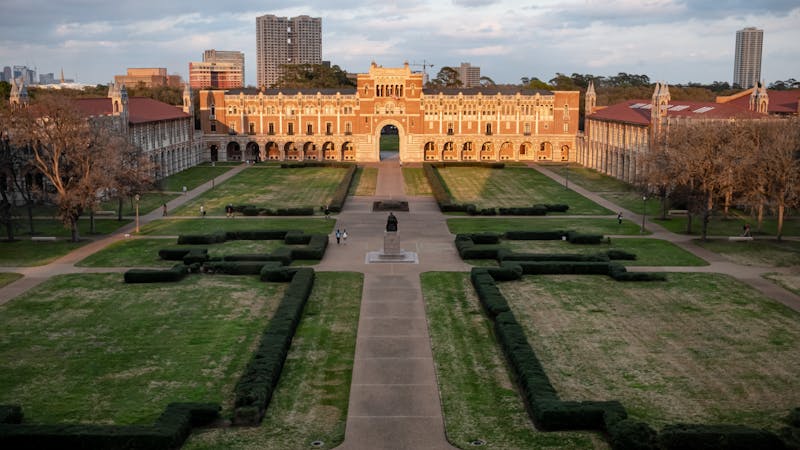Rice ranks 28th in low-income accessibility
Rice ranked 28 out of 179 top colleges, both liberal arts and research universities, in an index of the best colleges for low-income students published in the New York Times last month
The New York Times article was based on quantitative factors such as percentage of students receiving Pell Grants, the graduation rate of low-income students and the average net price for low- and mid-income students.
Vice President of Enrollment Chris Munoz said he disagrees with the methodology of the ranking. According to Munoz, many parts of the Rice experience that make it egalitarian are not quantifiable, and therefore discounted the ranking. For example, he said the residential college system makes the social environment much friendlier and less stratified than traditional Greek life.
“You’re not competing for a social position,” Munoz said, in reference to the placement of students in residential colleges. “[The college system] creates a more open environment where students with different stripes and interests might find us more appealing.”
Student Association President Jazz Silva said she believes Rice has an inclusive social environment.
“I don’t think you get a lot of class stratification blatantly out in the open,” Silva said. “I don’t think that people are ostracized for being low-income.”
Rice placed first in an August ranking of race and class interaction by the Princeton Review.
However, Rice ranks outside the top 50 for the factor “Pell Grad Share,” the number of students who receive Pell Grants, a form of governmental financial aid, multiplied by recipient graduation rate
According to the National Review, low-income students nationwide are not proportionally represented at top colleges and are less likely to achieve high grades. Overall, 20 percent of high-income students qualify as high-achieving while that number is less than 5 percent for low-income students.
Lovett College freshman Gunny Liu offered a contrasting viewpoint to those of the other students.
“Kids from disadvantaged backgrounds don’t really make it here [to Rice] because of their poor educational opportunities,” Liu said.
Program Director of the Center for College Readiness Sonya Ramirez pointed to Rice’s many resources, including peer advisors, the Center for Written, Oral, and Visual Communication, and the Center for Career Development in helping low-income students achieve their goals.
“Rice has one of the highest graduation and retention rates for its students, and much of this can be attributed to the supports available to Rice scholars,” Ramirez said.
According to Ramirez, who also serves as the advisor for Generation College, Rice’s mission of engagement with the local community is helping to combat the challenges facing low-income students coming to Rice.
“Through the various K-12 opportunities available at Rice, Houston area students are getting to know Rice early in their academic careers,” Ramirez said. “There are opportunities for all students to engage ... with the Rice community.”
According to Munoz, campus involvement helps integration into the Rice community. “My advice for any student is to be involved,” Munoz said. “The involvement can take place in ways not based on financial requirements.” Silva offered a contrasting viewpoint to the idea that low-income students can always get involved on campus.
“You’re not going to find a lot of economic diversity in terms of the people working at student-run businesses or people who are holding positions of power and have a lot of free time,” she said. “Low-income students have to work.”
Lovett College President Griffin Thomas proposed a Student Access and Success Working Group to the Student Association.
“Rice already does a tremendous job of supporting all students and fostering inclusivity and diversity,” Thomas, a junior, said. “Yet more can always be done. My goal for the working group is two fold: to reach out to the student body to create a comprehensive list of the specific challenges low income and first gen[eration] students encounter and work with relevant administrators and faculty members to begin to address these challenges.”
The Student Access and Success Working Group will be launched on Wednesday at the SA Senate Meeting.
More from The Rice Thresher

Rice accepts 13% of record-setting ED applications
Rice accepted 13.2% of Early Decision applicants in its first round of admissions for the class of 2029, said Yvonne Romero da Silva, vice president for enrollment. With 2,970 total applicants, this year saw yet another record-high; a 3% increase from last year’s previous high of 2,886. An additional 100 students gained admission through the Questbridge National College Match program, an uptick from last year’s 77.

Students reject divestment proposals
The student body voted to pass S.REF 01, which asks the Rice Management Company to disclose all of its holdings investments, but rejected the remaining divestment proposals. While every ballot measure gained a majority of votes in favor, the remaining three did not achieve the two-thirds majority required to pass.

Student organizations form coalition to support SA referenda
Four Student Association referenda open for the general student body vote today at noon. The referenda call for disclosure of Rice Management Company holdings and divestment from entities that profit off the Israel-Hamas war. The referenda also ask that Rice release a statement condemning genocide and materially support anti-colonial scholarship. Voting will close Dec. 11 at noon and the results will be published the next day. For the referenda to pass, a two-thirds majority with a 20% student body turnout is needed.

Please note All comments are eligible for publication by The Rice Thresher.